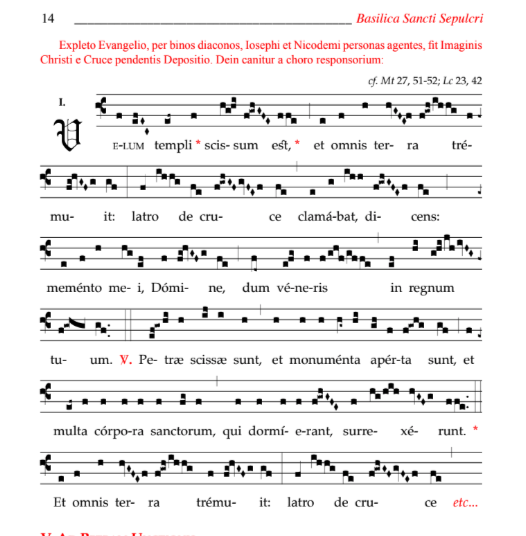 |
| At the Stone of Unction, the Custos sprinkles incense on the Body of Christ during the Funeral of Christ |
Most Catholics will be familiar with the multi-part reading of the Passion Gospel during the liturgies of Holy Week in the Roman Rite. In previous centuries all throughout Europe, elaborately staged, mimetic enactments of the Passion took place in and out of the liturgy, but especially during the Gospel of the Liturgy of the Presanctified.
The Good Friday Procession for the Burial of Our Lord survived in the Rite of Braga, even after the general adoption of the Roman Rite and the various Tridentine prohibitions regarding these florid Passion dramas of the Middle Ages. The ceremony has also survived in the Holy Sepulcher by a similar accommodation.
For the liturgy of Good Friday, the Tridentine Missal prescribed the three-part recitation of John’s Gospel, and nothing more. The Franciscans of the Holy Sepulcher faithfully adopted the Tridentine reforms, but preserved the Funeral of Christ (Processio funebris Feria IV in Parasceve) by transferring it out of the Liturgy of the Presanctified to the evening of Good Friday.
 |
| Passion play on the city square in Antwerp, Gillis Mostaaert |
The ceremony unfolds in seven stations, following nearly the same route as the daily procession. At each station, the corresponding verses from various Gospels are read, with certain dramatic elements accompanying the crucifixion, deposition, anointing, and burial of the latter stations. Originally, each station featured a homily and not a Gospel reading, but the homilies became too long and so they were replaced by Biblical texts, now read in vernacular languages.
Readers can follow the ceremony beside our commentary in the Ordo processionis funebris pro feria IV in Parasceve, itself taken largely from the 1925 Ordo Processionum (pp. 69 et sqq in the PDF), or watch videos from past years here and here.

II. The Six Stations and their Gospels
(1) The Chapel of the Apparition/Mary Magdalene (Mt 20: 1-5; 20 - 25, Italian)
(2) Shrine of the the Division of Christ’s Garments (Mk 14:53 - 72, Greek or Polish)
(3) Shrine of the Crowning and the Improperia (Lk 22:66-71; 23:1-12 , German)
(4) The Chapel of the Crucifixion, Latin altar, (Place of Crucifixion) (Jn 19:1-16), English)
(5) The Chapel of the Crucifixion, Greek altar (Place where Christ Expired) (Jn 19:17-37, French)
(6) The Stone of Unction (anointing ceremony and Arabic sermon)
(7) The Tomb or Aedicule (Jn 19:38-42, Spanish)
a) First through Fourth Stations: From the Chapel of the Apparition to the Chapel of the Crucifixion (Ad capellam apparitionis; Ad capellam divisionis vestimentorum; Ad columnam coronationis et improperiorum; Ad locum crucifixionis D.N.J.C)
The procession begins at 8:10pm in the Chapel of the Apparition, with the following ministers:
The Custos (the superior of the Franciscans in the Holy Land and custodian of all the holy sites) in alb, stole, and cope, who is assisted by the Vicar of the Custody and the Steward, vested the same way; six priests in Franciscan habit and four deacons in dalmatics; the Secretary of the Custody in stole bearing a special crucifix on which an effigy of Christ with articulated limbs has been affixed; and nearly three-hundred friars and local clergy take part, all in surplices.
The black vestment set used by the Custos and four deacons is a 19th century Spanish set.
Each station begins with a chant, after which one of the six priests dons a black stole and reads the Gospel passage that corresponds to the station, retaining the stole after his reading. On the way between the stations, the cantors chant the Miserere (Psalm 50) with the antiphon Parce Domine between each verse.
The procession begins, like the daily process, at the Chapel of Mary Magdalene, also known as the Chapel of the Apparition, which is located to the north of the Tomb and is the part of the Holy Sepulcher belonging to the Latin Church, and thence passes through the shrines in the ambulatory to the various stations. There is no explicit dramatic element until the fifth station in the Shrine of the Crucifixion, on the far side of the ambulatory next to the southern door.
The shrine is built on top of Mt. Calvary itself, the exposed rock of which can be seen in several places. One has to climb up a steep staircase to reach the top. The shrine is richly decorated with frescos, scores of lamps and candles and a large crucifixion scene above the Greek altar, The Altar of the Crucifixion proper. The two Latin altars south of the Greek altar commemorate the place of crucifixion (The Altar of the Nails of the Cross or the Medici Altar) and the Mother of Sorrows, the place where Mary stood.
The procession goes first to the Latin altar--at the place where Christ was nailed to the Cross--for the fourth station.
b) Fifth Station: The Deposition (Ad locum ubi Christus in Cruce exspiravit)
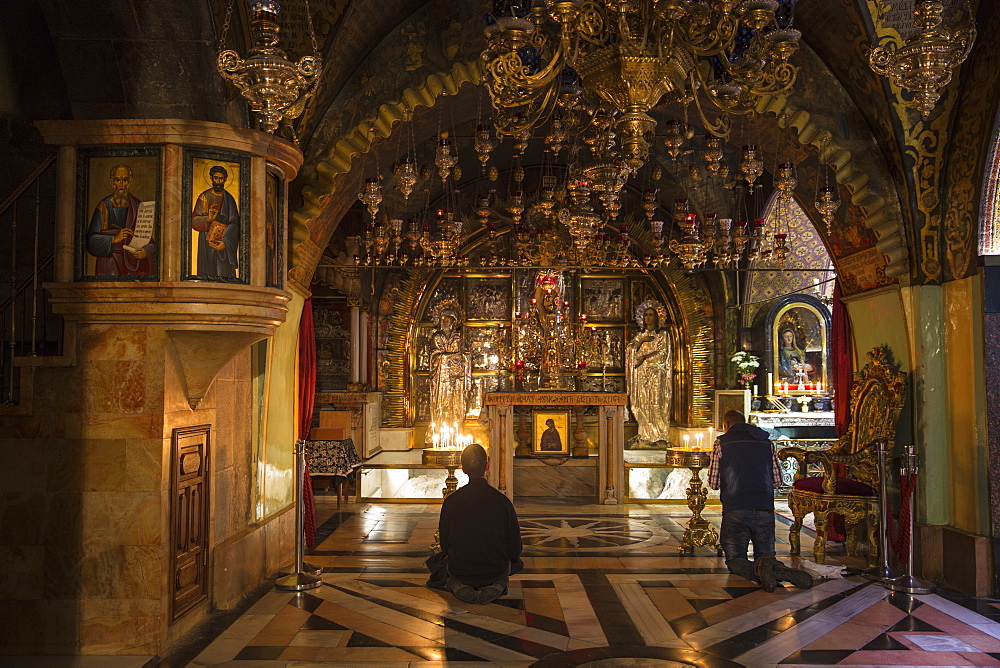
When the Gospel of the fourth station is finished, the procession passes to the Greek altar (which the Latins are allowed to use uniquely for this ceremony) where the processional cross is taken behind the Greek altar and placed to the very hole where the Holy Cross was inserted into the stone of Mt. Calvary:
Deinde ad locum ubi Christus exspiravit proceditur, et collocatur Crux in ipso foramine Calvariæ rupis ubi Crux Christi erecta fuerat. Hic habetur quinti Evangelii lectio Gallico idiomate.
At the point in the Gospel reading when Christ expires on the Cross, there are some moments of silence, and then a deacon finishes the Gospel, which tells of Joseph of Arimathea’s intercession with Pilate, in an elaborate chant tone.
At the end of the Gospel, two of the deacons. representing Joseph of Arimathea and Nicodemus, remove their dalmatics to perform the deposition ceremony:
Expleto Evangelio, per binos diaconos, Iosephi et Nicodemi personas agentes, fit Imaginis Christi e Cruce pendentis Depositio.
The ceremony takes place in solemn silence, except for three hammer strokes. First, the Crown of Thorns is removed, and placed on a silver platter donated by Charles V.
The two deacons behind the Cross remove the nails from Christ’s hands and feet, first striking the wood of the Cross with a hammer. The first deacon removes the first nail from Christ’s right hand. When the nail is removed, the articulated arm of Christ slides down at the shoulder. Likewise, after a second hammer stroke rings out in the silence of the chapel, the second nail is removed, and the other arm swings down. Likewise for the third nail, and all are placed in a second plate. The Body is lowered from the cross with a white cloth.

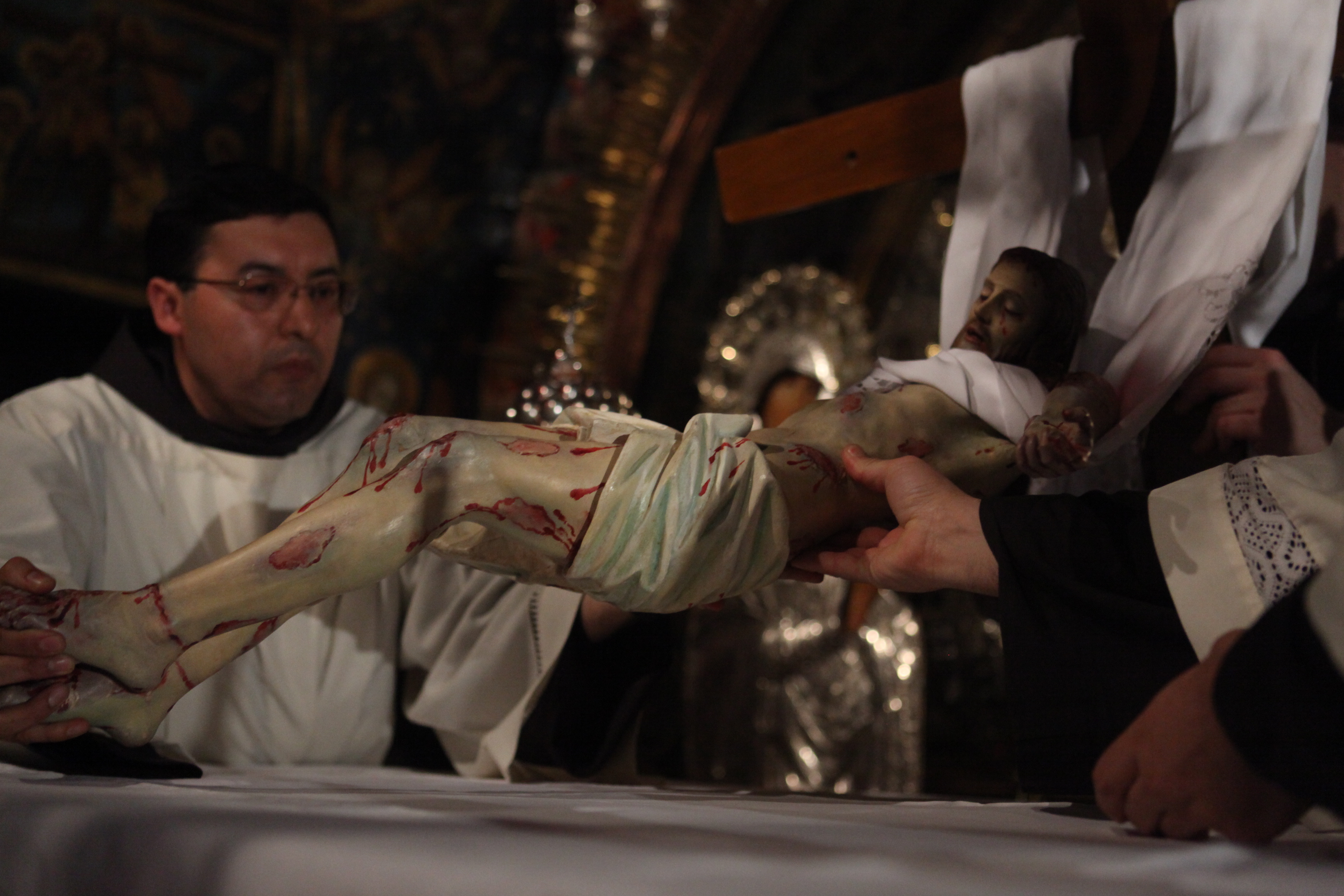
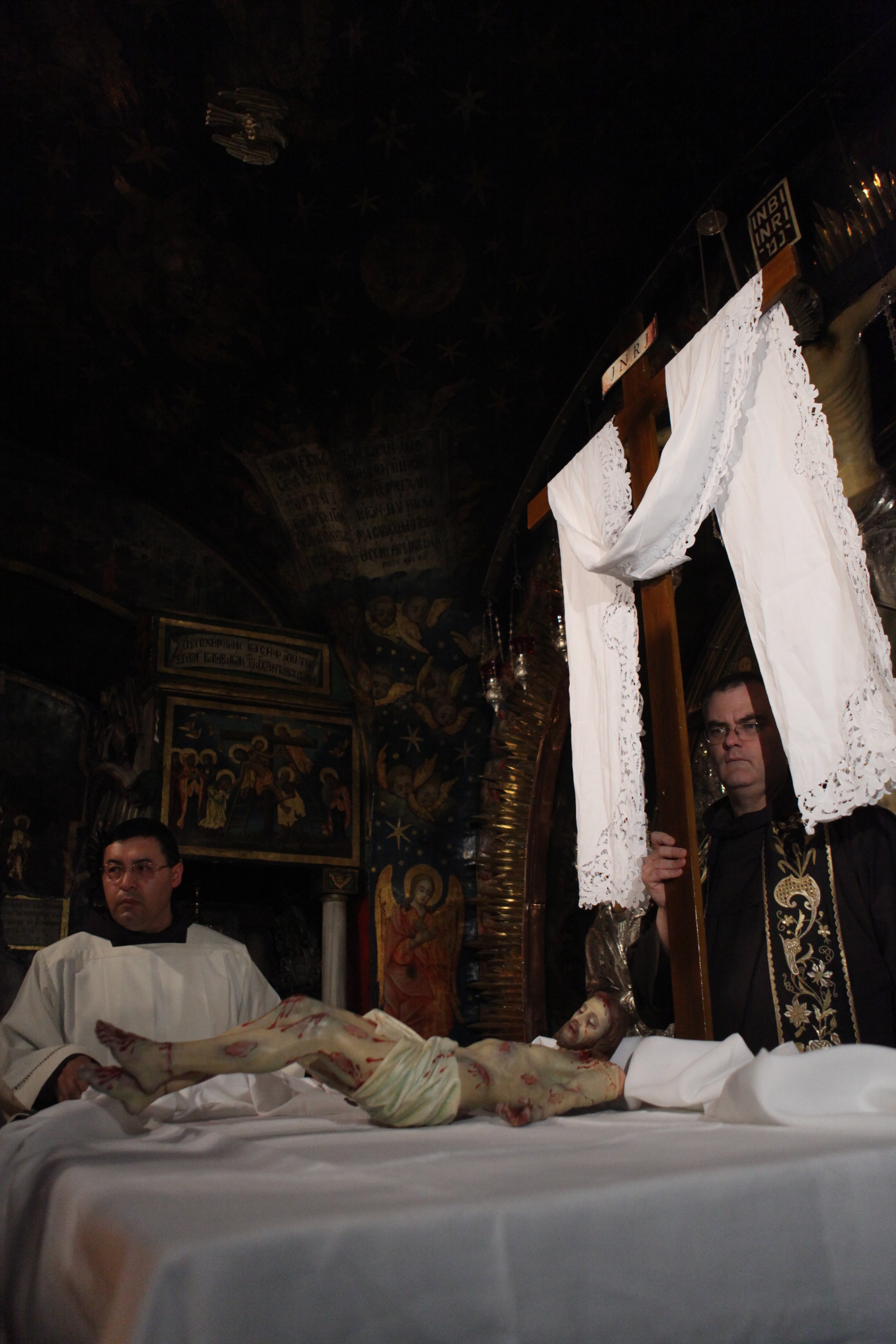


The deposed Christ is laid on the altar where the burial shroud has been spread. The choir begins the chant Velum templi scissum est.
c) Sixth Station: Anointing at the Stone of Unction (Ad petram unctionis)
At this point, the six priests in stoles bear the body down the mountain of Calvary to the Stone of Unction. Here the Custos removes his cope and girds himself with a towel to anoint the body.
The anointing consists of three parts.
(1) The Custos sprinkles grains of incense onto the uncovered Body.
(2) He then anoints the Body with myrrh.
(3) Finally, he incenses the Body.








The Stone of the Unction stands directly opposite the Southern door (the only modern entry point into the Sepulcher). A large mosaic depicting the deposition and anointing provides the backdrop for this moving ceremony.
After the anointing, a homily is delivered in Arabic for the local faithful.
d) Seventh Station: The Burial in the Tomb or Aedicule (Ad sanctum sepulchrum)
After the anointing, the Body of Christ wrapped in the Shroud is carried to the Tomb by the six priests, where it is reposed in the Tomb of Christ Himself and incensed to the chant Sepulto Domino.



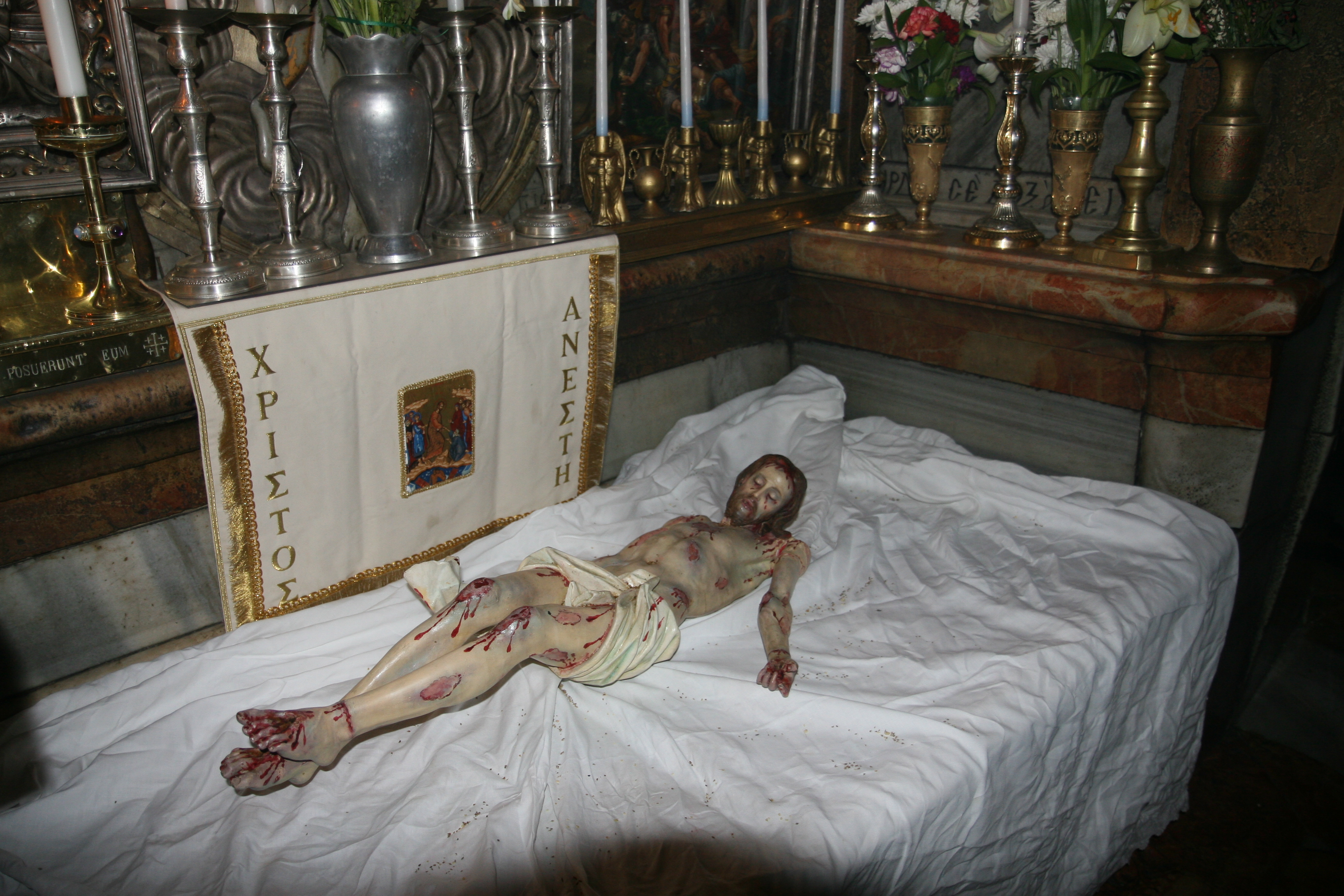


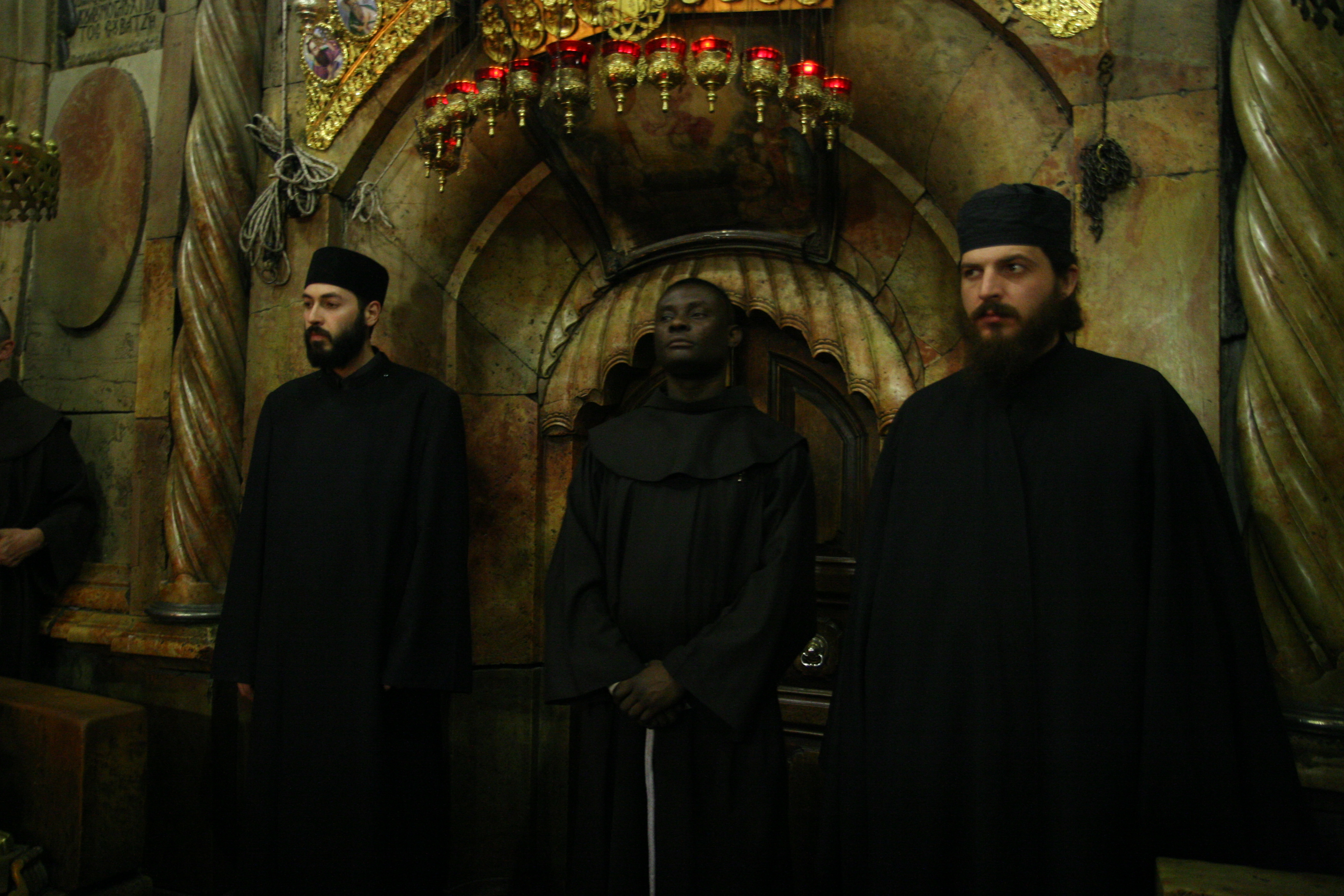
The ceremony ends with the Christus factus est, then the Custos reads the following prayer, after which the clergy depart for the sacristy in silence:
Réspice, quǽsumus, Dómine, super hanc famíliam tuam, pro qua Dóminus noster Iesus Christus non dubitávit mánibus tradi nocéntium et crucis subíre torméntum. Qui tecum vivit et regnat in sǽcula sæculórum. Amen.
*Unless otherwise noted, the photographs in this post are provided courtesy of the Franciscan Custody of the Holy Land.
This article is being printed in advance of Holy Week. During Easter Week, we hope to post an eye-witness account of this year’s ceremony, along with a more in-depth look at the historic vestments, vestments, and decorations used during the Procession.







